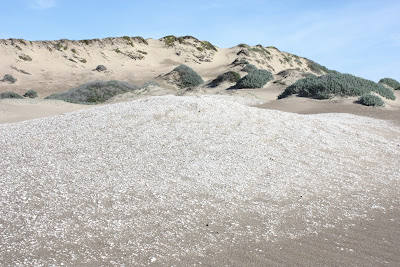
I sometimes run the paved neighborhood road, and then the sandy trail out to the dunes and over to the Morro Bay Sand Spit, but I seldom walk the same route. On a beautiful Saturday morning, February 5, my wife joined me for a walk along this route. I strapped my scope and tripod onto my back, and took my binocs and camera for the 6 - 8 mile walk from my house. I wanted to enjoy a walk with my spouse, and also find some of the sandy beach birds I had not yet seen on my 2011 walking green year, such as Snowy Plover and scoters. From my house it's less than a mile to the sandy trails that wind through the coastal scrub of Montana de Oro State Park. A mixture of lupine, coyote bush, manzanita and other vegetation supports California Thrashers and Quail, White-crowned Sparrows, Wrentits, Bushtits and other permanent residents as well as winter visiting Golden-crowned Sparrows, Blue-gray Gnatcatchers (photo above) and Ruby-crowned Kinglets. I listened and looked for Sage Sparrows that used to live in this habitat, but discovered none.
 After about 30 minute's walk we came to the dunes that separate the coastal scrub flats from the beach. This line of dunes extends the length of the Morro Bay Sandspit that separates the Ocean from the Morro Bay estuary (photo below). Morro Rock was visible just past the tip of the spit - about four miles away. South of the spit, the dunes run along the beach before gradually diasappearing into the bluff tops that overlook the rocky and sandy shore in most of the park. The way over these dunes is take-your-breath-away and fill-your-shoes-with-sand steep in many places, but we took the now required path that is a less steep route across the dunes and over to the usually cold and windy beach. The vegetation changes and becomes much more sparse on the beach; low growing ice plant, verbena, sea rocket and other plants prevail in patches above the high tide line. Some were (already? still?) blooming and it was surprisingly warm!
After about 30 minute's walk we came to the dunes that separate the coastal scrub flats from the beach. This line of dunes extends the length of the Morro Bay Sandspit that separates the Ocean from the Morro Bay estuary (photo below). Morro Rock was visible just past the tip of the spit - about four miles away. South of the spit, the dunes run along the beach before gradually diasappearing into the bluff tops that overlook the rocky and sandy shore in most of the park. The way over these dunes is take-your-breath-away and fill-your-shoes-with-sand steep in many places, but we took the now required path that is a less steep route across the dunes and over to the usually cold and windy beach. The vegetation changes and becomes much more sparse on the beach; low growing ice plant, verbena, sea rocket and other plants prevail in patches above the high tide line. Some were (already? still?) blooming and it was surprisingly warm!Once we got to the beach shore we did not see many birds. It seemed deserted by the birds. In the winter this usually means dogs, ranger vehicles or a Peregrine Falcon. We saw none of these as we walked north. Line after line of large breakers flattened out as they neared our footprints in the packed sand. After a mile or so we began to see flocks of Sanderlings feeding along the shore with gulls, and much larger groups of many shorebird species standing in the dry sand. This included a handful of Snowy Plovers (new year bird) hunkered down into depressions in the sand and running off, like little furry white tennis balls, if we approached too close. One had colored bands on it's legs (photo below) which indicated that it had been banded at Salinas Sate Beach where it had nested the summer before - over 100 miles to the north of where we were. The large flocks included Dunlin, Western and Least Sandpipers, Sanderlings and the plovers (photo below).
 As we walked farther north we started to see large rafts of scoters on the ocean, in and beyond the waves. Scping fromn the low dunes on the beach, I could identify the common Surf Scoter but wasn't sure about any other scoters. Then a jet ski came from the north and flushed the scoters. The White-winged Scoters were now obvious as they flashed there white wing patch, and I counted 14 as they flew by in the flocks of several hundred scoters. Both of the scoters were new for my walking green year. The White-winged can be difficult to find here, so I was happy with this addition.
As we walked farther north we started to see large rafts of scoters on the ocean, in and beyond the waves. Scping fromn the low dunes on the beach, I could identify the common Surf Scoter but wasn't sure about any other scoters. Then a jet ski came from the north and flushed the scoters. The White-winged Scoters were now obvious as they flashed there white wing patch, and I counted 14 as they flew by in the flocks of several hundred scoters. Both of the scoters were new for my walking green year. The White-winged can be difficult to find here, so I was happy with this addition.On the way back we stopped at a couple of native Chumash (pre-European indiginous people) shell middens (garbage dumps) (photo below) which have discarded shells from long ago meals, cooking stones, bird bones, stone flakes and other pieces. If you are lucky you can find a spear point or other stone utensil. We didn't see any such points this visit. I stopped to take photos on the walk back, but no additional birds species showed up.







No comments:
Post a Comment